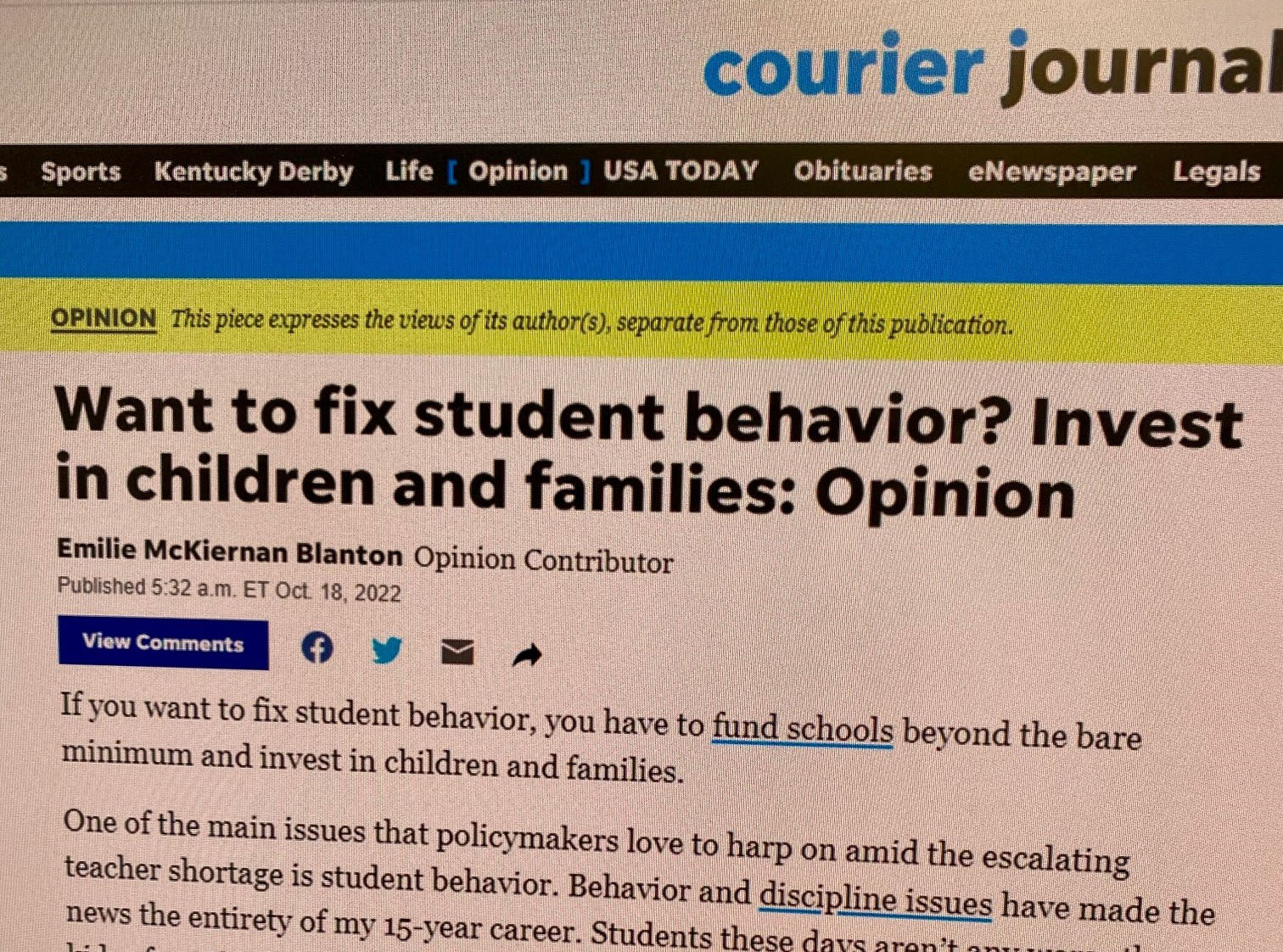
Volume 58, Issue 9
MEMBER VOICES: KEA member Emilie McKiernan Blanton had her voice heard on the Op/Ed page of the Oct. 18 issue of the Courier Journal.

Reprinted with permission from Emilie McKiernan Blanton
If you want to fix student behavior, you have to fund schools beyond the bare minimum and invest in children and families.
By Emilie McKiernan Blanton, a KEA member, fifteen-year teacher veteran and elected member of the JCTA Board of Directors. She teaches at Southern High School in Louisville and is the mother of two JCPS students who have been personally affected by the teacher shortage even before COVID.
One of the main issues that policymakers love to harp on amid the escalating teacher shortage is student behavior. Behavior and discipline issues have made the news the entirety of my fifteen-year career. Students these days aren’t any worse than kids of previous years. Kids are human beings like adults with less experience and less impulse control. They’re not “bad,” they’re reacting.
Behavior is a form of communication. When needs aren’t being met, students will let you know by telling you and sometimes that looks like a behavior outburst. While there are some who want an out of sight, out of mind approach to this issue, that is not what is best for children to grow and learn to be better. So, what can we do?
 Children require more one-on-one time with their teachers. Just reducing classes from 31 down to 25 can have drastic differences on how a classroom feels for both students and teachers. This would require more funding to pay for the additional staff required to lower class sizes to a more manageable load. This means more personal interactions with students, more immediate feedback, and just less people to be around.
Children require more one-on-one time with their teachers. Just reducing classes from 31 down to 25 can have drastic differences on how a classroom feels for both students and teachers. This would require more funding to pay for the additional staff required to lower class sizes to a more manageable load. This means more personal interactions with students, more immediate feedback, and just less people to be around.
Our schools are in desperate need of makeovers. A common meme teachers share is comparing the sterile, blank government-funded classroom to a colorful, lively teacher-funded classroom. That’s not an exaggeration at all. Without unpaid time decorating and money out of teachers’ own pockets to pay for everything from colorful posters to classroom books, classrooms are largely devoid of any joy without the touch of a teacher. Without teachers spending their own time and money on classrooms, the rooms are dull, lifeless, and honestly depressing. Our students deserve to walk into rooms that are warm and inviting and our teachers deserve to not be the people footing the bill.
Emilie McKiernan Blanton
It’s not just the classroom decorations. We have schools in Kentucky with snakes falling from ceilings and poor ventilation that need serious building upgrades. In fact, JCPS has over a billion dollars in facility upgrade needs. (source: https://budget.jefferson.kyschools.us/Working_Budget_Reports/Working%20Budget%202020-21%20%20%2009-21-20.pdf page 63) What does it do to kids to walk into buildings needing renovations that our government is unwilling to fund? There is no reason JCPS and Kentucky can’t be leading models on how to treat children with respect and dignity by giving them buildings they are proud to walk into every day.
Outside of the classroom, our children and families need more supports to help them be successful. Children do not exist just inside of school buildings. Our students are struggling with a host of societal issues that should not be thrust upon children. Sometimes they go to bed hungry. Sometimes they have to work to help their families make ends meet. Sometimes their parents are working two and three jobs leaving kids with minimal supervision and guidance. I hear a lot of talk about pulling yourself up by your bootstraps but that’s hard when you were born barefooted and hungry to start. When we talk about student behavior, we have to talk about a massive contributing factor: poverty. As many as a quarter of Kentucky children live in poverty (source: https://kyyouth.org/kentuckys-child-poverty-rate-remained-steady-from-2018-to-2019/) and 5,000-6,000 students in JCPS were identified as homeless in 2020. (source:https://spectrumnews1.com/ky/louisville/news/2020/11/24/homeless-youth-awareness) What does it do to a child to go hungry, not know where they will sleep that night, and then walk into school and be expected to behave regardless of the circumstances.
When we talk about behavior, we have to understand that complaining about behavior is meaningless unless policymakers are willing to put up the money necessary to give kids a chance. Is student behavior a contributing factor to the teacher shortage? Sometimes, but we have to address it at the root cause instead of saying “kids these days” and shaking our heads as teachers struggle and our most vulnerable population, our children, are left with the consequences of inaction.
Our students need parents who can make a living wage with just one job. Our students need parents who can take leave for parenting issues without fear of losing their job. Our students need mothers who get paid maternity leave. Our students need a fighting chance starting from the cradle and carrying them through to adulthood. Our children deserve the opportunity to be successful regardless of their circumstances of birth. Our children deserve better.
More Articles:
KEA Member Charlotte Buskill awarded $25,000 Kentucky Milken Educator Award
Constitutional Amendment 1 soundly defeated at ballot box as voters back balance of power
PRO’S CORNER: KEA’s Teacher of the Year how to make lesson planning easier with Planboard by Chalk
Want Training? Sign up on KEA’s Learn Upon learning portal
‘Nation’s Report Card’ shows opportunity gaps that already existed made worse by pandemic
